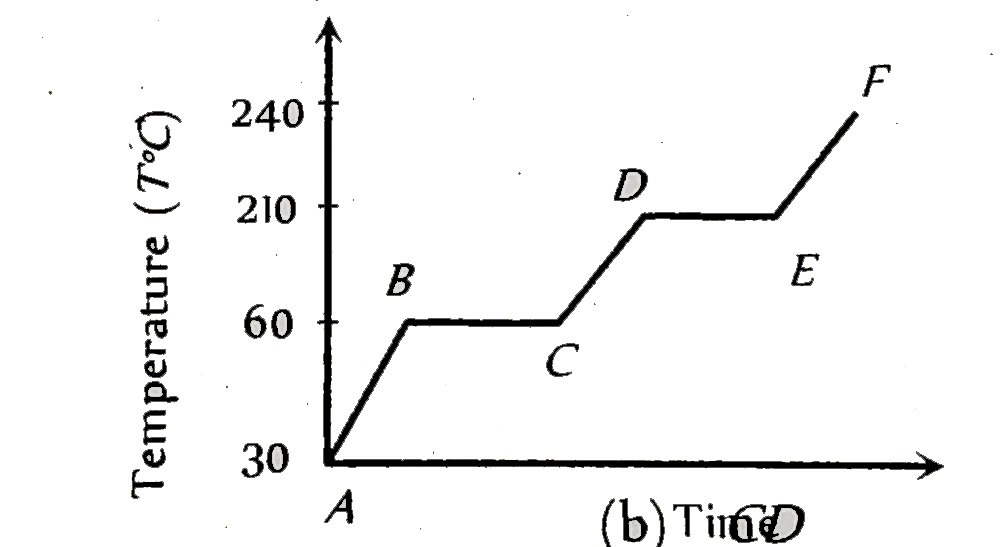Two solid blocks having same mass but different material are supplied heat at a constant rate. They have same initial temperature. The graph between temperature and time is shown.

Answer the following questions on the basis of information given in the above statement.
Which material has higher specific heat capacity in solid state?
Material 1
Topper's Solved these Questions
- HEAT AND TEMPERATURE BOOK - CENGAGE PHYSICSCHAPTER - HEAT AND TEMPERATURE EXERCISE - CONSOLIDATED EXERCISE (Multiple Choice Questions with one or More than One Correct Answer)
4 Videos
- HEAT AND TEMPERATURE BOOK - CENGAGE PHYSICSCHAPTER - HEAT AND TEMPERATURE EXERCISE - CHALLENGING EXERCISE
5 Videos
- HEAT AND TEMPERATURE BOOK - CENGAGE PHYSICSCHAPTER - HEAT AND TEMPERATURE EXERCISE - MANDATORY EXERCISE (Exercise Set III)
29 Videos
- HEAT AND MECHANICAL ENERGYBOOK - CENGAGE PHYSICSCHAPTER - HEAT AND MECHANICAL ENERGYEXERCISE - Olympiad and NTSE Level Exercises
7 Videos
- LASERSBOOK - CENGAGE PHYSICSCHAPTER - LASERSEXERCISE - OLYMPIAD AND NTSE LEVEL EXERCISES
1 Videos
Similar Questions
Two solid blocks having same mass but different material are supplied heat at a constant rate. They have same initial temperature. The graph between temperature and time is shown.

Answer the following questions on the basis of information given in the above statement.
Which material has higher specific heat capacity in gaseous state?
View SolutionTwo solid blocks having same mass but different material are supplied heat at a constant rate. They have same initial temperature. The graph between temperature and time is shown.

Answer the following questions on the basis of information given in the above statement.
Which material has higher specific heat capacity in liquid state?
View Solution
Knowledge Check
A solid material is supplied heat at a constant rate. The temperature of material is changing with heat input as shown in the figure. What does the slope of DE represent ?
 ALatent heat of liquidBLatent heat of vaporizationCHeat capacity of vapourDInverse of heat capacity of vapour
ALatent heat of liquidBLatent heat of vaporizationCHeat capacity of vapourDInverse of heat capacity of vapourA well insulated substance in solid state is heated at a constant rate until it vaporizes completely. The temperature-time graph of the substance is shown below . Which of the following statements is//are true?
_E01_077_Q01.png) AThe specific heat capacity of the substance in solid state is greater than that of the substance in liquid state.BThe specific latent heat of fusion of the substance is greater than the specific latent heat of vaporization of the substance.CIf the rate of heating increases, the slope of AB will be increased but the length of BC remains unchanged.DIf the mass of the substance is doubled, the length of DE is also doubled but the slope of CD is halved.
AThe specific heat capacity of the substance in solid state is greater than that of the substance in liquid state.BThe specific latent heat of fusion of the substance is greater than the specific latent heat of vaporization of the substance.CIf the rate of heating increases, the slope of AB will be increased but the length of BC remains unchanged.DIf the mass of the substance is doubled, the length of DE is also doubled but the slope of CD is halved.A solid substance is at 30∘C . To this substance heat energy is supplied at a constant rate. Then temperature versus time graph is as shown in the figure. The substance is in liquid state for the portion (of the graph)
 ABCBCDCEDDEF
ABCBCDCEDDEF
Two solid blocks having same mass but different material are supplied heat at a constant rate. They have same initial temperature. The graph between temperature and time is shown.

Answer the following questions on the basis of information given in the above statement.
Which material has higher latent heat of vaporisation?
View SolutionTwo solid blocks having same mass but different material are supplied heat at a constant rate. They have same initial temperature. The graph between temperature and time is shown.

Answer the following questions on the basis of information given in the above statement.
Which material has higher latent heat of fusion?
View SolutionA solid material is supplied heat at a constant rate. The temperature of material is changing with heat input as shown in the figure. What does the slope of DE represent ?

View SolutionA well insulated substance in solid state is heated at a constant rate until it vaporizes completely. The temperature-time graph of the substance is shown below . Which of the following statements is//are true?
_E01_077_Q01.png)
View SolutionA source of heat supplies heat at constant rate to a solid cube. The variatiion of the temperature of the cube with heat supplied is shown in figure. The portion DE of the graph represents conversion of

View Solution
